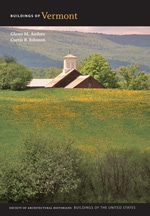
This small one-and-a-half-story, wood-frame house is a good example of the adaptation of a simple vernacular type into popular housing in a more “urban” setting. In form and plan, the house is the two-room cabin used for modest farm and village homes in Vermont since the eighteenth century. Beginning with A. J. Downing's The Architecture of Country Houses (1850), it regularly appears in pattern books and reports on workers' housing as a small “workman's cottage.” Here it is oriented gable end to the street to fit on a small urban lot, a bay window is centered in the gable end, a small porch on the left side shelters the main entrance, and it is decorated with elaborate Queen Anne stickwork siding. It is one of four identical houses constructed side by side by local contractor John Roberts after King Street was extended to this block in 1885 by feed and grain dealer C. P. Smith, who built the houses as rental units. Roberts, listed as a “contractor and builder” in directories of the time, is thought to be responsible for numerous houses, identical but for varied Queen Anne details, built on infill lots throughout Burlington during the 1880s. Roberts himself resided in a vernacular Italianate-style house extant at 227 N. Willard Street.

